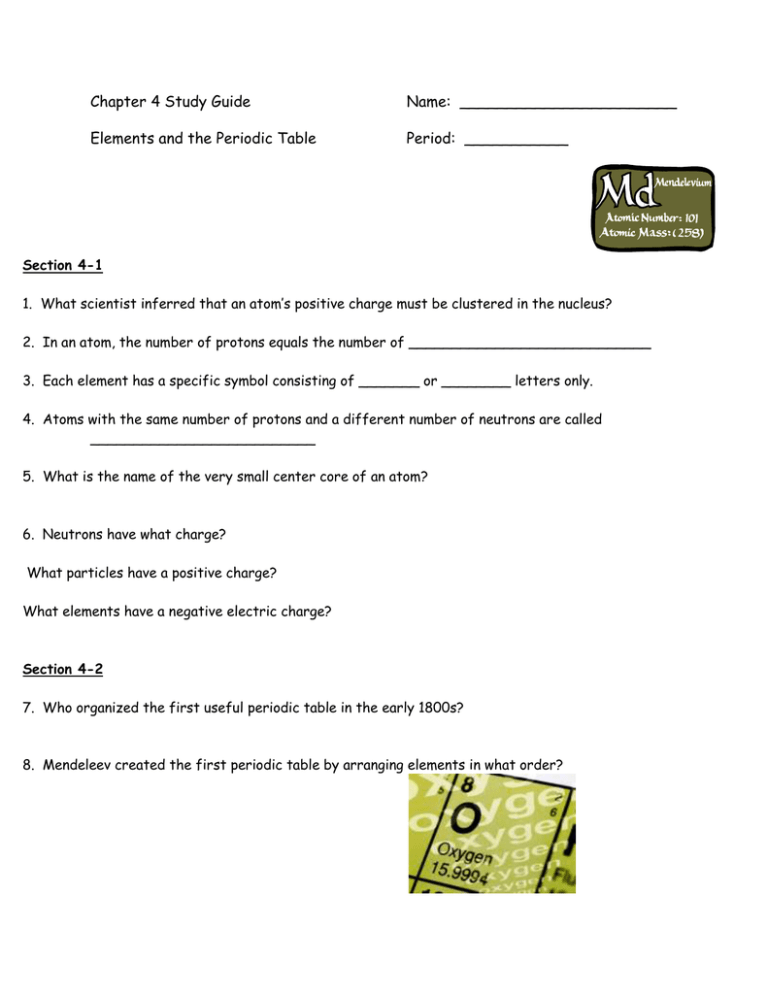Chapter 4 Study Guide Name: Elements and the Periodic Table
advertisement

Chapter 4 Study Guide Name: _______________________ Elements and the Periodic Table Period: ___________ Section 4-1 1. What scientist inferred that an atom’s positive charge must be clustered in the nucleus? 2. In an atom, the number of protons equals the number of ____________________________ 3. Each element has a specific symbol consisting of _______ or ________ letters only. 4. Atoms with the same number of protons and a different number of neutrons are called __________________________ 5. What is the name of the very small center core of an atom? 6. Neutrons have what charge? What particles have a positive charge? What elements have a negative electric charge? Section 4-2 7. Who organized the first useful periodic table in the early 1800s? 8. Mendeleev created the first periodic table by arranging elements in what order? 9. How did chemists change Mendeleev’s periodic table in the early 1900s? 10. The sun is made up mostly of what element? 11. The elements in a column of the periodic table have similar ____________________________ 12. What information in the periodic table indicates the number of protons in an atom? 13. What prediction did Mendeleev make that came true less than 20 years later? 14. How is the modern periodic table organized? 15. The horizontal rows in the periodic table are known as ___________________________. 16. The elements in a group in the periodic table have similar ________________________. 17. Each element is given an specific _______________________, made up of one or two letters. Section 4-3 18. At room temperature, most metals are in what state of matter? 19. True or False: Metals show a wide range of chemical properties 20. In the periodic table, the most reactive metals are found in which group? 21. To make most synthetic elements, scientists use powerful machines called _________________ 22. Which group contains the most elements? 23. A material is said to be ductile if it ___________________________________________ 24. The two most common alkaline earth metals are _______________________ and ___________________ 25. Elements with atomic numbers higher than 92 are not found naturally on Earth, so they must be made, or ________________________, by crashing nuclear particles into each other. 26. The chemical reactivity of metals tends to increase from __________ to ____________ across the periodic table. 27. The most chemically reactive metals are in Group ______ of the periodic table. 28. Describing a metal as ____________________ means that it can be pounded into a new shape. 29. What are the two most important alkali metals? Section 4.4 30. Which property of bromine could you NOT predict based on the fact that it is a nonmetal in the halogen family? a. b. c. d. highly reactive poor conductor of electricity liquid at room temperature poor conductor of heat 31. Which group of elements shares characteristics with both metals and nonmetals? 32. The elements that do not ordinarily form compounds are the ____________________ 33. Fluorine, chlorine, bromine, and iodine are part of a family called ______________________ 34. At room temperature, all the metalloids are solids, while most nonmetals are _______________ 35. True or False: In general, the physical properties of nonmetals are similar to the properties of metals. 36. Atoms of the halogen family of elements typically gain ____________ electrons when they react. 37. Elements that form diatomic molecules, or molecules of two atoms each, are commonly found on the _______ side of the periodic table. 38. Nonmetals are ______________ conductors of heat and electricity. . Use the diagram to answer each question. 39. If a metal reacts violently with water, in which group is it likely to be found? 40. Most of the elements that form a zigzag line in the periodic table belong to one major group. What is that group, and what kinds of properties do its elements tend to have? 41. Locate the box in Group 18 in the fourth period. Predict the state of matter and the chemical reactivity of the element that belongs in that box. 42. What name is given to the elements in Groups 3 through 12?



